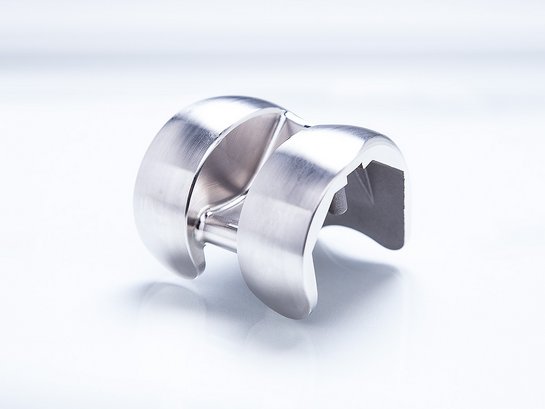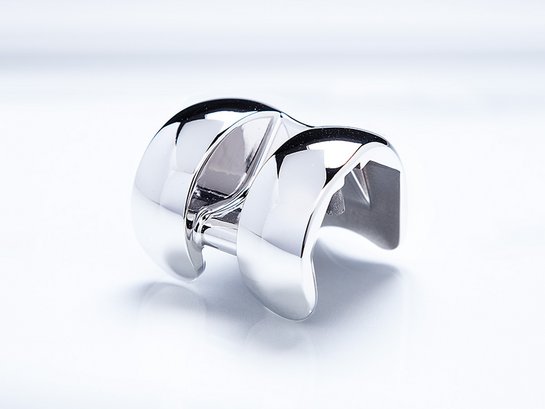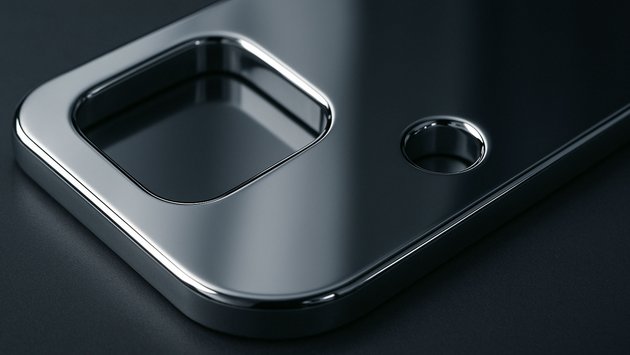

Zeer gladde en glanzende oppervlakken worden algemeen beschouwd als teken van bewezen kwaliteit en esthetiek. Maar een perfect gepolijst oppervlak kan ook noodzakelijk zijn voor de optimale werking en levensduur van een product.
Gepolijste en gladde oppervlakken zijn een lust voor het oog en een puur genot om aan te raken. Mooie verfijnde sieraden en bestek bijvoorbeeld krijgen zo hun “finishing touch”.
Voor veel producten dient het polijsten en gladmaken echter geen esthetisch doel, maar is het een voorwaarde voor een soepele functionaliteit. Bijvoorbeeld in de medische technologie, de turbinebouw en de automobielsector is er vraag naar hoogwaardige oppervlakken met een lage ruwheid. Het polijsten van werkstukken kan enerzijds slijtagegedrag optimaliseren en anderzijds het energieverbruik en de geluidsontwikkeling minimaliseren.
Wij bieden onze klanten hiervoor een eigen assortiment slijpmedia en polijstpasta's. Wij hebben ook een breed gamma van verschillende glijslijpsystemen voor natte en droge processen. Bij de keuze van de juiste systeemtechnologie moet bijzondere aandacht worden besteed aan de handling van de te bewerken onderdelen, want hoogwaardige oppervlakken vereisen een behoedzame behandeling tijdens de bewerking, maar ook bij de logistiek voor en na de bewerking.
Applications and Technologies for high gloss metal objects and surfaces

Polishing, stainless steel polishing, high-gloss polishing, and smoothing often evoke vivid images: shiny rims reflecting sunlight without a single scratch, premium jewelry polished to perfection, polished stainless steel, or orthopedic components such as extremely smooth knee joints and medical instruments.
Polished stainless steel surfaces in kitchens resist dirt and water stains. Mirror-finish surfaces appeal visually and offer a tactile pleasure.
Polished surfaces offer more than aesthetics: they are often necessary for technically flawless usability - stainless steel surfaces, for instance, are used in the food industry because they are more hygienic and easier to clean.
Polishing and smoothing (mass finishing) are also applied to ensure processes run “frictionlessly.” High-performance surfaces with low roughness are in demand in medical technology, turbine construction, and automotive applications. Polishing in these areas can optimize cleaning, wear behavior, energy consumption, and noise levels.
Polishing enhances both visual and functional qualities of smooth surfaces. This can be achieved mechanically (ranging from cloth, polishing compounds, or polishing wheels to mass finishing systems as classic polishing equipment) or chemically.
Targets often include roughness values under Ra 0.05 μm, sometimes reaching Ra 0.02 μm. Preprocessing through grinding and cleaning is usually vital before the polishing step. In industrial environments, mass finishing is often the most cost-effective method for polishing and smoothing small to medium-sized parts. We offer customers a dedicated program of abrasive media and polishing compounds, along with a wide range of vibratory and mass finishing systems for both wet and dry processes.
When selecting the best equipment, special attention should be given to part handling. High-quality surfaces - particularly demanding stainless steel surfaces - require gentle treatment during processing and careful handling before and after finishing.
ISF® and Keramo-Finish®:
Specialized Methods for Polishing and Smoothing

- ISF® and Keramo-Finish® are applied in high-precision surface finishing of components with special demands, such as in aerospace or automotive applications.
- ISF® is a chemically assisted mass finishing process that produces smooth, strength-enhancing surfaces using conversion-layer forming compounds and abrasive media. It improves lifespan, reduces friction and noise, and is also known as the "REM process," producing super-fine, glossy, or decorative surfaces.
- Keramo-Finish® uses special ceramic polishing media and fine polishing compounds to gradually polish surfaces to high-gloss. Early stages remove more material, while final stages achieve high-gloss finishes with extremely low roughness (up to Ra 0.03 μm) while densifying the surface for durability and improved functionality.
The special challenge: polishing and smoothing stainless steel
Technical challenge
Polishing stainless steel is much more demanding than processing conventional metals. This is due to the special properties of the material - above all its low thermal conductivity, high toughness, and natural passive layer of chromium oxide. These factors make stainless steel technically challenging, but also particularly durable and corrosion-resistant.
Thermal and mechanical characteristics
Heat dissipation is particularly important in mechanical polishing processes. Heat can lead to discoloration, surface damage, and increased susceptibility to corrosion. Good temperature control, low cutting speeds, and additional cooling are therefore essential. Stainless steel is also mechanically demanding: it tends to work harden and “smear” during polishing instead of removing cleanly. This slows down the process and requires a coordinated approach with suitable tools and abrasives.
In addition, stainless steel is sensitive to scratches. A high-quality surface therefore requires a step-by-step approach with finely graded grit sizes and thorough cleaning between processing steps. Uniform processing is particularly difficult with complex geometries, but is necessary to ensure dimensional accuracy and a homogeneous finish.
Special Methods and Safety Considerations
The passivation layer may be damaged by mechanical polishing and must be restored chemically or via electropolishing, which offers uniform, stress-free removal. Chemical or plasma polishing is also used for medical and food-grade surfaces.
Quality, Standards, and Cost Efficiency
Industries such as food and medical technology demand strict surface quality, often defined by roughness (e.g., Ra < 0.8 μm). Quality assurance uses visual inspections, roughness measurements, and corrosion testing. Stainless steel polishing is more labor-intensive and costly than other metals due to longer processing, specialized equipment, media, and post-treatments.
However, polished stainless steel surfaces are durable, hygienic, and low-maintenance, making the investment worthwhile.
Our experts will be happy to advise you on your specific challenge in the field of stainless steel polishing.
Importance of Stainless Steel Polishing in Medical Technology
Stainless steel is one of the top three materials used in medical technology. It is primarily used for everyday items such as surgical instruments, operating tables, and syringe sets. These items must meet the highest hygiene standards to prevent the colonization of germs and bacteria. Stainless steel is particularly suitable as a manufacturing material because it is corrosion-resistant, easy to clean, and biocompatible. Appropriate surface treatment maximizes the positive effect that the material inherently provides: a polished and smoothed stainless steel surface is easier to clean and sterilize, which supports the highest hygiene standards in medical applications. In sensitive areas such as surgery or implant technology, this is crucial for patient safety. Visual and haptic requirements also play a role, for example in instruments that must be guided with precision. Overall, polishing and the use of stainless steel materials contribute significantly to the functionality, safety, sustainability, and quality of medical technology products.
What should you know about polishing and smoothing?
Frequently asked questions
What is the difference between polishing and smoothing?
Polishing, including stainless steel, is a fine finishing method to create shine/high-gloss with minimal material removal. Smoothing primarily reduces surface roughness, with appearance ranging from finely textured to polished.
Which materials can be polished?
Almost all solid materials: tool steel, stainless steel, aluminum, brass, copper, titanium, hard metals, ceramics, plastics, glass, and crystalline materials can be polished.
What are the main polishing methods?
Mechanical polishing (manual, machine, cloth, or polishing wheel with loose abrasives), electrolytic polishing, DryLyte (dry electropolishing), plasma polishing, Isotropic Superfinishing (ISF®), mass finishing (vibratory finishing), dry or wet polishing, Keramo-Finish®, or ball polishing.
Mechanical vs. electrolytic polishing
Mechanical polishing, including mass finishing in wet or dry modes, uses abrasive media and mechanical motion. Electrolytic polishing, such as the DryLyte process, combines electrochemical material removal with mechanical movement.
Achievable roughness values
Depending on pretreatment, roughness can reach up to Ra 0.05 μm.
Does polishing improve corrosion resistance?
Polished or smoothed surfaces have fewer defects, scratches, or burrs where moisture and dirt could accumulate, improving corrosion resistance. For extensive protection, polishing is combined with passivation or coating depending on material and application.
Applications Across Industries
- Medical technology:
Polished surfaces are vital for biocompatibility, hygiene, and cleanability of instruments, implants, and medical devices. - Automotive:
Polishing and smoothing optimize aesthetics (e.g., rims), wear, energy efficiency, noise, and torque transmission. - Food, pharma, and chemical industries:
Low roughness prevents dirt and microbial adhesion and facilitates cleaning. - Mechanical engineering and bearing industry:
Polished and smoothed surfaces improve tribological properties and reduce energy and noise. - Aerospace:
Smooth surfaces minimize drag, prevent material fatigue, and enhance aerodynamic efficiency.
Gebruik de Solution Finder om de juiste machine voor uw bewerkingsproces te vinden.
